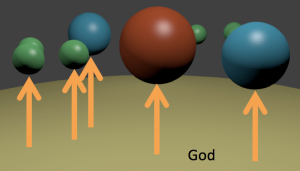
In this first picture, I represent some arbitrary things in our world as different sized and colored balls. These could be subatomic particles, planets, or even human beings. The arrows pointing between them show causal relationships between them. At the subatomic level it would include the electrical and nuclear forces which particles exert on each other. For stars, planets, and moons, it would primarily be the force of gravity. Between people, it would be words and deeds by which we influence each other. In all of these ways, one thing causes something to happen to another thing. These are all secondary causes. Notice that the arrows are double headed, which indicates that the influence is almost always to some extent mutual. For example, in the case of a pebble on the surface of the Earth, the Earth exerts a gravitational pull on the pebble, and the pebble also exerts a gravitation pull on the Earth.

The second picture is just the first one as seen from the side. It shows another dimension, which was not clear in the first picture, where we see that God is affecting all of the things. This is the primary cause, which gives the thing its existence as well as its ability to function as a secondary cause. Notice that the arrows only point in one direction. This shows that God causes the things of the universe, but they have no causal effect on God. God is completely uncaused.
It is this role of God as primary cause of everything that is behind the Christian practice of thanking God for every blessing, even when we know where it came from. For example, when I was a kid, I thought it was strange that we thanked God for our food, when I knew good and well that my mother had cooked the food, which she bought from the grocery store, with money earned by my father. I knew the food in the store came by various process ultimately from plants and animals raised on farms. I also knew about the natural process behind the growth of these plants and animals, and I saw no reason put God in the mix. Now I know that God is behind every little part of that process by which we receive our food.
There is a blessing said by the priest in every Catholic Mass (according to the post-Vatican II liturgy at least) which I think illustrates this.
Blessed are you, Lord God of all creation,In this little prayer, we first see God acknowledged as Lord of all creation, the implication being that it is because he is the creator. We have the bread due to God's goodness, including his continual work as primary cause. "Fruit of the earth" acknowledges the natural processes that act as secondary causes to bring forth the wheat used to make the bread, and "work of human hands" acknowledges the human agents also involved as secondary causes. Finally, the last line refers to the sacramental action of God, through the priest as secondary cause, that will make the bread the Body of Christ, food for eternal life.
for through your goodness we have received
the bread we offer you:
fruit of the earth and work of human hands,
it will become for us the bread of life.
1 comment:
[...] two previous posts, I described the idea of primary and secondary causation, which has its roots in the classic [...]
Post a Comment